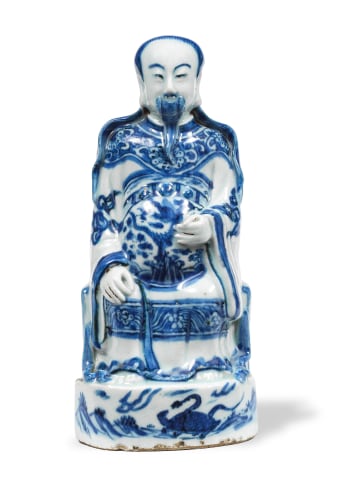BH64
Literature
Zhenwu's origins can be traced to the Warring States (3rd century BCE) and Han Dynasty (206 BCE - 220 CE). Originally known as Xuanwu ('The Dark Warrior'), he was represented by a tortoise entwined with a snake. The tortoise, as depicted in the present figure, rules the 'Cold North' cardinal point of the Chinese compass. Xuanwu is an ancient symbol of the north; the other three cardinal directions are represented by the dragon, the red bird, and the tiger. At the start of the eleventh century CE, Xuanwu was transformed into the Taoist deity of the North, Chen-Wu, represented in warrior form. Chen-Wu received great popularity in the Ming Dynasty (1368-1644).
The following is an extract from Catalogue One, Solveig Gray and Anita Gray
Chinese Porcelain (please note this extract uses the Wade-Giles romanisation system, so Zhenwu appears as 'Chen Wu'):
"Hsuan-T'ien Shang-Ti, The Lord of the Night Sky, also called Chen Wu,
was first heard of during the Chou period (1154-1121 B.C.). At fifteen years of age he left his parents and under the tutelage of the patriarch Tzu-hsu learned the wonderful doctrine and was given a magic sword. On the peak of a mountain he practised for forty-two years the exercises which brought him the ability to float, etc. Having mastered this he was invited to the celestial regions, where he had conferred upon him the title Hsuan-T'ieh Shang-Ti, First Lord of the Highest Heaven. His name Hsuan Wu is said to be the name of the North Star.
The name Hsuan Wu was changed to Chen Wu by the Sung Emperor Chen Tsung (A.D. 998-1023) because Hsuan was part of his own name. In the Yuan Dynasty he was granted the honorary title of Leading Good and Majestic Saint, First Lord of the Highest Heaven. Mention is made in the Ming-Shih of a temple built in 1416 for sacrificing to Hsuan Wu under the title of "Veritable Saintly and Helpful Master of the Pole Star."
A Cizhou figure of Chen-Wu, dated 14th-15th century, is in the collection of the Minneapolis Institute of Art (accession number 2003.201). For a Ming blue and white example, see the Grandidier collection at the Musee Guimet (collection number G1562)
A related figure of the God of Literature, Zhenwu, Wanli, is illustrated by A.du Boulay, Christie's Pictorial History of Chinese Ceramics, Oxford, 1984, p.140, no.4.

